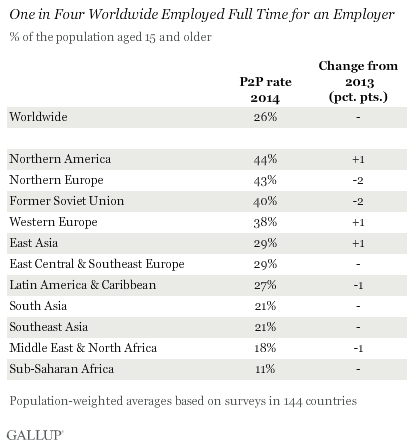Another Gallup: Huge gap persists in global jobs
http://www.gallup.com/poll/183485/huge-gap-persists-global-jobs-2014.aspx
A dramatic gulf in economic activity separated countries with the highest and lowest percentages of their populations working full time for an employer in 2014. The 10 countries with the highest Payroll to Population (P2P) rates in 2014 all had P2P rates of 44% or more, with Qatar and the United Arab Emirates at the top. Meanwhile, the countries with the lowest P2P rates -- most of them in sub-Saharan Africa -- ranged from 7% to just 3%.

Gallup's Payroll to Population rate, the percentage of the total adult population who works at least 30 hours per week for an employer, remained stagnant at 26% in 2014. Gallup's latest global P2P measurements are based on more than 182,000 interviews across 144 countries in 2014, in which adults were asked a battery of employment questions modeled from International Labour Organization (ILO) standards. Gallup does not count adults who are self-employed, working part time, unemployed, or out of the workforce as payroll-employed in the P2P metric, and it is not seasonally adjusted.
Regionally, Northern America continued to have the highest percentage of adults working full time for an employer in 2014, at 44%, and sub-Saharan Africa continued to have the lowest regional rate at 11%. The Middle East and North Africa (MENA) had the second-lowest rate (18%), despite two countries in that region ranking at the top of the list in 2014: Qatar at 62% and the United Arab Emirates at 61%. The populations in these two countries, along with others in the Persian Gulf region, include large percentages of expatriates who live in the country just to work -- which contributes to their higher P2P rates.
P2P increased by one percentage point in East Asia, Northern America and Western Europe, matched by increased workforce participation (East Asia and Western Europe) and lower rates of part-time work (Northern America). P2P decreased by two points in Northern Europe and the former Soviet Union, matched by increased part-time work and decreased workforce participation.

I did an OP recently on
US labor participation rates that gets in to this. We're roughly in the middle of the industrialized world in terms of labor participation, and our discouraged workers rate is very low, at 0.5%.

